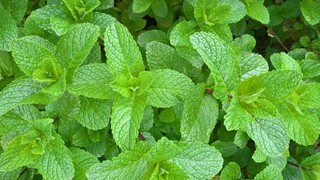How to grow mint indoors

Anytime you plant mint in garden beds, it tends to spread rapidly, sending out runners to quickly take over any space it can access (not limited to garden soil, it often creeps into cracks between pavers or in concrete). Because of its prolific nature, mint is a great option for growing indoors in containers, where growth is contained.
Mint is an excellent herb for growing indoors in containers. For optimum growth, plants need indirect sun exposure and daytime temperatures between 65 and 70°F. Grow plants in plastic containers, keeping well-draining growing media consistently moist.

Supplies for planting mint
Like many other herbs, mint needs only the basic supplies to grow it indoors.
Containers
When choosing containers for growing, look for wide, shallow, plastic pots with drainage holes.
- Plants from the mint family like the root zone moist; mint does best when its “feet” are slightly wet. Plastic containers keep the growing media damper than porous containers like terra cotta that allow better air movement.
- Mint is known for its prolific growth and rogue runners. Wide containers provide plenty of space for new shoots to pop up without causing constriction of the roots.
Our favorite pot for growing mint is the 8” Bloem planter; you can buy it at Amazon here.
Growing media
Coconut coir and potting soil are two of the most common options for indoor gardening. They are lightweight and have excellent water retention while allowing excess moisture to drain out the growing media quickly.
- Potting soils contain no soil but are a mix of peat moss or coconut coir, pine bark, perlite, and vermiculite. Our top pick for potting soil is FoxFarm, and you can find it here on Amazon.
- Coconut coir is a renewable material made from the brown and white fibers found between the shell and the outer coating of a coconut seed.
To learn more about the best substrate for container-grown herbs, read our post on growing media.
Plants
This quickly growing plant does best when grown from cuttings taken from existing mint plants versus planting seeds.

The enthusiast's guide to herbs
We’re proud to present our new e-book, The Enthusiast’s Guide to Herbs! Learn everything you need to know about growing and caring for herbs indoors, including in-depth info cards for the 35 most commonly grown herbs.
Click the link below to find out more!
How to grow mint indoors from stem cuttings
It is easier and more reliable to propagate a new mint plant from stem cuttings than to sow new plants from mint seed. Propagating from cutting saves money, but this also means mint doesn’t grow well as a microgreen.
- Take a 5 to 6-inch stem cutting just below a node. Remove all of the mint leaves from the bottom 2 inches of the stem.
- Place the cut end of the stem in a glass or jar of water, allowing it to grow until new roots form and reach a couple of inches long.
- Fill container(s) with the pre-moistened growing media of your choice.
- Carefully plant newly rooted mint cuttings in the potting mix or coir, spacing at least 10 inches apart.

Best indoor growing conditions
Most homes are well suited for growing houseplants and herbs alike. Most indoor plants prefer warm, sunny locations and thrive when given optimum conditions including the proper sunlight exposure, ambient temperature, and relative humidity.
Indirect sunlight exposure
Unlike many herbs and houseplants, mint thrives in indirect sunlight versus full sun and even grows well in partial shade. Choose east-facing windows in spring and summer and west-facing windows in fall and winter.
If you’re using grow lights, do your best to imitate the effects of indirect sunlight. Be sure to use mild intensity lights in scheduled periods.
If you’re looking for a good supplemental grow light, we recommend this one that you can find on Amazon.
Ambient Temperature
For the healthiest plants, keep mint containers in rooms where the year-round temperature is between 65 - 70°F during the day and 55 - 60°F at night. Protect plants from cold drafts to prevent adverse responses to environmental stress.
Relative Humidity
Indoor plants are not a fan of dry air, and herbs are no exception. Maintain a humid environment with adequate airflow to keep foliage healthy. Plants can be grouped to increase the relative humidity, but be sure to allow some spacing between plants for air movement. If you live in an arid climate or are using direct sunlight, be diligent with your watering to compensate.
Basic care for growing mint indoors

- Keep the growing substrate/soil moist. Don’t let the surface of the growing media dry out between waterings as you do with other plants. Mint likes moist, but not waterlogged, conditions around its roots due to its Mediterranean stream bank origin. Be careful when you water mint though, excess water can cause root rot.
- Rotate plants in your herb garden every few days to prevent them from bending towards the light. This phenomenon is known as phototropism – where plant growth hormones are laterally redistributed to the shade side of the plant, triggering cell elongation, encouraging the plant to grow towards the sunlight.[1]
- Avoid fertilizing plants. Mint plants proliferate without a need for additional nutrients. Overfertilizing culinary plants can cause prolific vegetative growth and result in the leaves losing their robust flavor.
- Pinch or prune plants regularly to keep them from getting leggy. This removes apical dominance and enhances the growth of lateral branches,[2] creating bushier plants.
- Remove flowers to prevent loss of flavor and prolong leaf growth. Pinch off buds as they develop, encouraging plant resources to go towards creating new foliage.
How to harvest mint
Depending on your plant’s health, you can harvest mint 2-3 times per growing season. The leaves are delicate enough that you can simply pull the leaves off as needed. Just make sure to take care with the integrity of the mint stem when you’re harvesting.
Commonly grown varieties of mint
According to the Encyclopedia Britannica, there are many different types of mint – about two dozen species and more than seven thousand varieties in the plant family – that vary slightly in their flavor and characteristics. All kinds of mint have broad, green leaves that release a particular, distinctive menthol-based scent when bruised.
Peppermint and spearmint are the two most commonly grown types of mint, but apple mint, orange mint, and pineapple mint are also popular with gardeners.
| Mint Variety | Light Levels Needed | Appearance | Uses |
|---|---|---|---|
| Peppermint | Full sun is best, but will tolerate part shade | Bright green rounded leaves | Tea, syrups, infusions, chocolate desserts |
| Spearmint | Indirect light to part shade | Dark green pointed leaves | Savory dishes, salads, meats, drinks and teas |
| Apple Mint | Bright, indirect light | Light green, fuzzy round leaves | Sweet dishes, infused water, jelly, fruit dishes |
| Orange Mint | Full sun to part shade | Smoother, rounded leaves | Creamy desserts, fruit tarts, sauces, dressings |
| Pineapple Mint | Full sun to part shade | Fuzzy rounded leaves with white margins | Fruit salad, water, meat and fish, salsa, chutney, cocktails |
Peppermint
Peppermint (Mentha piperita) is the most recognized member of the mint family. This is for one specific reason: it contains more menthol (up to 40%) than other varieties and is well-suited for medicinal uses and flavorings. Peppermint oil helps calm nausea, relieve headaches, clear sinus congestion, and helps to fight infection. It is also a key flavoring agent in chewing gum and toothpaste.
Spearmint
Spearmint (Mentha spicata) is a slightly sweeter variety of mint. It has a considerably lower menthol content than peppermint, making it ideal for use as a flavoring agent to flavor things such as toothpaste, gum, confections, soaps, and shampoos. It has been used medicinally for millennia to treat minor ailments such as digestive disorders and fevers and has been shown to inhibit the growth of tumors.[3]
Apple Mint
Apple Mint (Mentha rotundifolia) is also known as wooly mint. This variety is cuter than its hairless cousins, with its fuzzy, velvety-green leaves. It is also less invasive than other mint varieties and is sometimes used as an ornamental plant for this reason, along with its attractive foliage. The flavor of apple mint is sweeter and more subtle than other mints, with no bitter aftertaste.
Orange Mint
Orange Mint (Mentha piperita citrata) is known for its intense fragrance redolent with notes of bright citrus and sweet lavender undertones. Also known as bergamot mint, this variety is frequently used to extract an aromatic oil used to scent perfumes and cosmetics. Over the years, it has been rumored to be the secret ingredient in the liquor Chartreuse—an herbally-flavored digestif first produced by Carthusian monks in the 1700s.
Pineapple Mint
Pineapple Mint (Mentha suaveolens ‘Variegata’) is without question the most beautiful of the mint cultivars. With creamy variegated leaves that set it apart from any other mint, it adds a lacy and delicate look to any indoor garden. Like its parent species, apple mint, pineapple mint is aromatic and citrusy with sweet, tropical undertones.
Uses for Mint

Not only is this fragrant herb easy to grow, but its wide range of uses makes it a welcome addition to any windowsill arrangement or indoor garden. For the most part, the uses for mint fall into either culinary or medicinal applications.
Culinary Uses
Sprigs of fresh mint are commonly added to cold drinks such as lemonades, iced tea, and even simple iced water to impart a refreshing, minty taste. Mint is also the staple of cocktails such as juleps and mojitos.
Mint pairs well with a variety of foods, ranging from meat dishes to even fruit concoctions. Mint jelly is a staple with grilled or roasted lamb; it is incorporated into grain salads such as tabbouleh and couscous, and mint is used for dips such as tzatziki.
Medicinal Uses
Mint plants contain antioxidants and anti-inflammatory compounds [4], lending themselves to offer many healing properties as a phytomedicine. They have been used to treat a range of ailments throughout history, from gastric discomforts to skin irritations and pain relief.
FAQ
Can you grow mint indoors year-round?
Yes, you can grow mint inside year-round, so you have a supply of fresh leaves whenever you need them. During winter months when plant growth slows, cut back slightly on watering—although make sure the growing media stays slightly moist—and supplement lighting with an LED grow lamp if necessary.
Does mint keep bugs away?
Yes, mint is a natural pest-deterrent because of its aroma. Mint is great at keeping aphids and fungus gnats, two of the most common indoor plant pests, at bay. It can also help keep flies, roaches, and spiders from infesting your home and repels mice, ants, and mosquitos.
Why is my mint dying?
When grown indoors, mint most often dies because of improper watering. Mint plants like their potting soil to stay consistently moist without being waterlogged. Make sure you are not underwatering or overwatering your plant; the top of the soil should be damp but not saturated.
Whippo, Craig W., and Roger P. Hangarter. 2006. “Phototropism: Bending towards Enlightenment.” The Plant Cell 18, no. 5 (May): 1110-19. doi.org. ↩︎
Mutetwa, M., Eve Beura, Mtaita Tuarira and M. Thomas. 2016. “The influence of pinching on the growth, flowering pattern and yield of butternuts (Cucurbita moschata).” International Journal of Horticulture and Ornamental Plants 2, no. 1 (October): 19-25. ↩︎
Craig, Winston J. 1999. “Health-Promoting Properties of Common Herbs.” The American Journal of Clinical Nutrition 70, no. 3 (September). doi.org. ↩︎
Brahmi, Fatiha, Madani Khodir, Chibane Mohamed, and Duez Pierre. 2017. “Chemical Composition and Biological Activities of Mentha Species.” In Aromatic and Medicinal Plants - Back to Nature, edited by Hany El-Shemy. London: InTechOpen Limited. ↩︎
